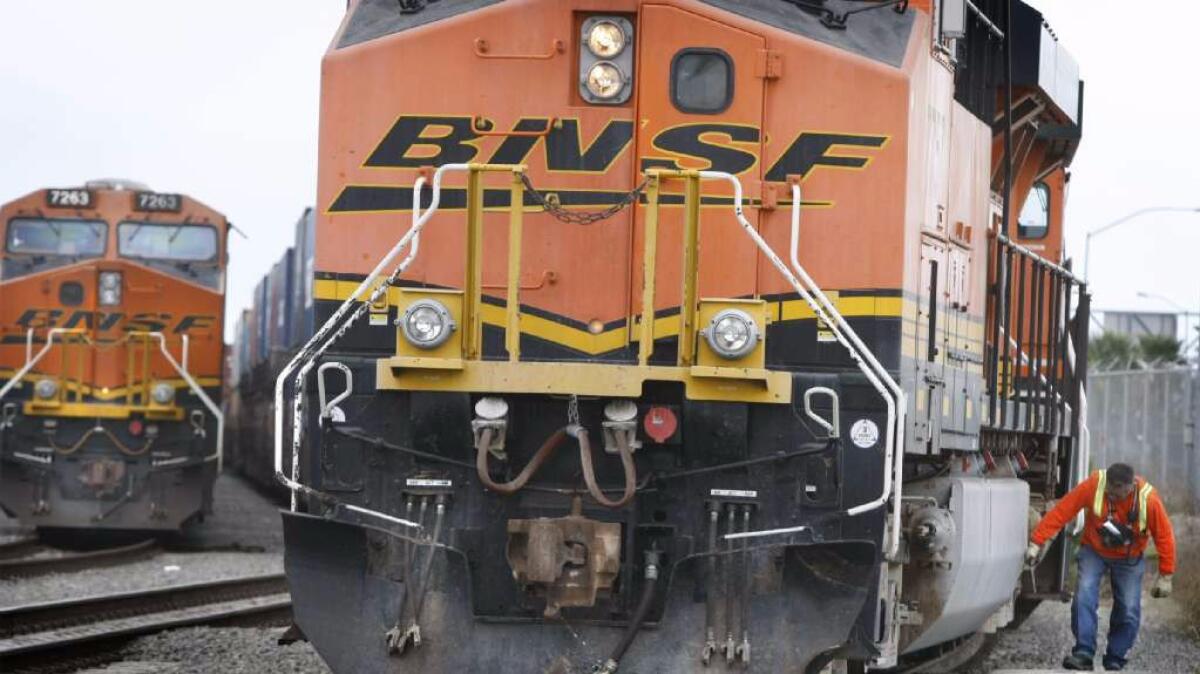Port of L.A. and railroad appeal a court decision that blocked a new freight yard in the harbor

- Share via
A railroad company and the Port of Los Angeles on Tuesday appealed a court decision that has stalled a $500-million freight yard they plan to build next to low-income, predominantly minority communities in the harbor area.
The Burlington Northern Santa Fe Railway Co. and harbor officials are seeking to overturn a decision in March by Contra Costa County Superior Court Judge Barry P. Goode.
Goode ruled that the port and BNSF violated state law by failing to adequately assess the environmental impacts of the proposed Southern California International Gateway, which is predicted to handle up to 8,200 trucks a day and the equivalent of 2.8 million 20-foot shipping containers by 2035.
The Port of Los Angeles prepared an environmental impact report that we strongly believe fully met all requirements of the California Environmental Quality Act
— Gene Seroka, Port of L.A.’s executive director
The judge upheld his decision late last month after hearing objections from the railroad, which argued that he could not, under federal law, require the port to rescind its approvals of the project.
If built, the 153-acre rail yard will be in Wilmington next to California 103 and east of Alameda Street between Sepulveda Boulevard and Pacific Coast Highway.
The huge staging center for trains hauling cargo from the harbor is bordered on the east side by schools, playing fields, parks, housing for homeless veterans and low-income, minority residential neighborhoods in west Long Beach, an area already hard hit by pollution from port operations.
In his 200-page ruling, Goode said that the analysis of air-quality impacts required by state law was “wanting” and failed to provide enough information “to foster informed public participation and reasoned decision-making.”
Goode also concluded that the cumulative environmental effects of the proposed rail yard and other operations in the harbor were not adequately assessed, including the project’s potential to foster growth at BNSF’s giant Hobart Yard near the interchange of Interstate 5 and the 710.
See the most-read stories in Local News this hour >>
The appeal claims, however, that the judge applied an inappropriate standard for evidence and disregarded a comprehensive eight-year environmental review that indicated the project would reduce air pollution, noise and truck traffic along the 710 freeway and in the harbor area.
“The Port of Los Angeles prepared an environmental impact report that we strongly believe fully met all requirements of the California Environmental Quality Act to inform the public and decision-makers of the project’s effects,” said Gene Seroka, the port’s executive director.
Rail and harbor officials also contend that Goode’s ruling represents an “incorrect and unprecedented expansion” of the scope of environmental review required by California’s environmental quality act.
Unless the ruling is promptly reversed, Roger Nober, BNSF’s chief legal officer, said the freight yard is less likely to be built due to the costs and delays caused by the environmental lawsuits.
One environmental group that sued the port and has pushed to limit pollution from the project put the blame for the legal wrangling on Los Angeles City Hall.
“Mayor Garcetti has failed to take the leadership role to make the Port of Los Angeles the greenest port in the U.S. and to protect the health of harbor and freight corridor communities,” said Jesse N. Marquez, executive director of the Coalition for a Safe Environment, based in Wilmington.
MORE LOCAL NEWS
Man shot by LAPD after ‘intense struggle’ at East Hollywood pharmacy, police say
‘Catastrophic’ charter bus crash leaves five dead, L.A. driver seriously injured
Former LAPD Chief William Bratton to resign as New York police commissioner
More to Read
Sign up for Essential California
The most important California stories and recommendations in your inbox every morning.
You may occasionally receive promotional content from the Los Angeles Times.














